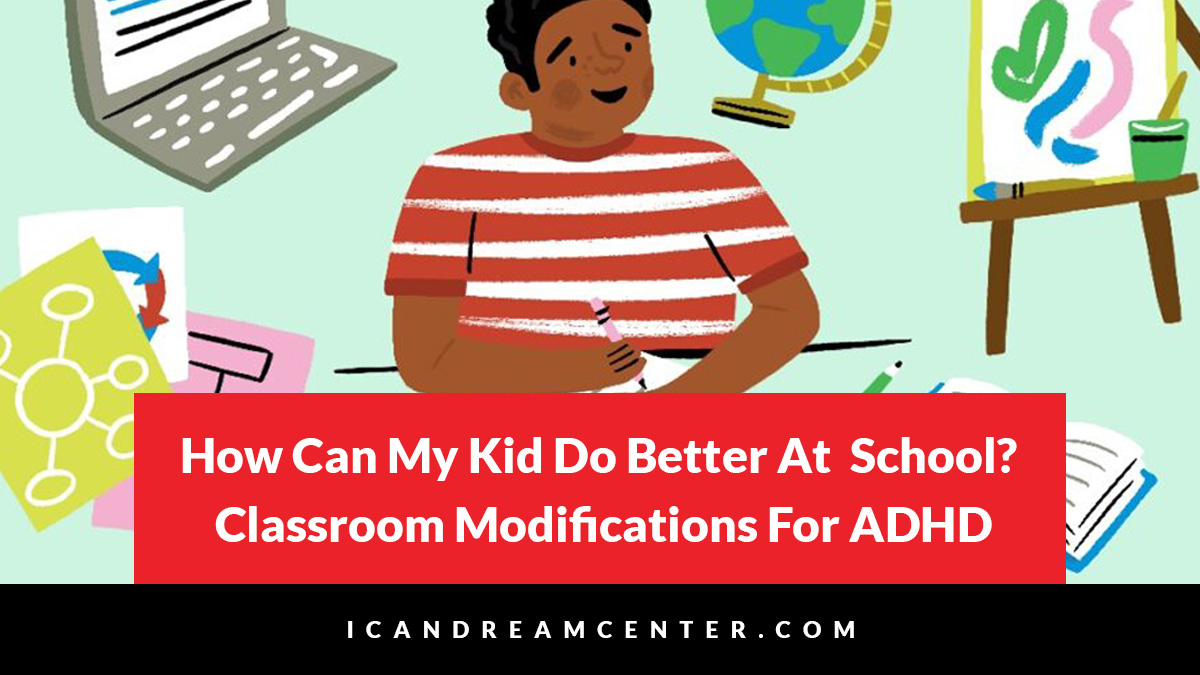
How Can My Kid Do Better At School? Classroom Modifications For ADHD
By Dr. Ford
Some kids take to learning like peanut butter and jelly. Others, more like oil and water. For teachers, witnessing an incredibly smart kid sitting in the back fidgeting with their pen, staring off into space, or being distracted with their cell phone is frustrating. Equally as frustrating? Wanting your kid to do well but seeing them struggle or do poorly in school. Engaging students with ADHD in the classroom can feel like an uphill battle.
Yet, all is not lost. With a few simple tweaks, both teachers and parents can help students to thrive inside and outside of the classroom.
Here are some tips:
Communicate With Your Child’s Teacher
Step one? Talk openly with your child’s teacher about ADHD. It may feel daunting and uncomfortable at first, but pushing past the taboo of keeping your child’s learning disabilities shrouded in mystery will help your child’s teacher provide support.
“It is imperative that the student’s teacher knows what a 504 Plan is and what the student’s particular accommodations are within the classroom,” says Wendy R. Tilford, an education consultant and college counselor who offers college planning, tutoring, and test prep services in the Houston, TX area. A “504 Plan” refers to a federal law that allows certain students to receive accommodations in school that will make it easier for them to learn. Tilford notes that most schools will issue 504 Plans for students with learning differences. These plans outline classroom accommodations based on each student’s individual needs.
One thing to note: A 504 Plan isn’t the same as an Individualized Education Plan. IEPs do more to tailor the school environment for special education students. That might include intensive support, such as the student being removed from the classroom to receive instruction from a special education teacher. A 504 Plan, on the other hand, suggests classroom modifications for students with learning disabilities.
As a parent, you can play a lead role in advocating for your child’s needs. Children who learn to speak up about what they need early in life manage their ADHD better as they grow and mature. This builds trust and confidence in the student.
Being Your Child’s Biggest Advocate
Evisha Ford, LCSW, EdD, is founder of the iCan Dream Center, an Illinois therapeutic school for neurodiverse youth and their parents. She found that her son, who has ADHD, felt anxious and reluctant to step into new spaces.
What she’s found useful is creating social stories with her son or “talking about changes and things that will happen.” This might involve having your child meet his or her teacher ahead of time, visit the classroom, and get acclimated with the environment to prepare for the change.
Ford also suggests creating predictability with “visual prompts [and] providing students with a visual schedule.” Diversifying classroom content and activities is one way educators can accommodate students with learning disabilities. But parents can also advocate for additional tweaks and modifications, such as:
- Using classroom props that allow students to use their senses and fine motor skills. Lakrisha Howard, who teaches second grade at a school in Newark, N.J., places an elastic kick band on her student’s chairs to give restless students a way to bounce their feet and focus in class. Teachers can also provide blocks, squeeze balls, and chewable rulers just to name a few.
- Assigning ADHD students classroom roles like collecting homework, distributing worksheets, or writing on the board. These kinds of tasks encourage students to focus and actively participate in the day’s lesson.
- Alternative seating options like standing desks, small armchairs, couches, exercise mats or free choice seating.
- Brain breaks with opportunities for ADHD students to switch “on” and “off” during work time. Sarah Spear, founder of Empowered Together, an online community for parents of students with disabilities, suggests finding ways to “segment time into focus and break intervals.” Even with small bits of time, students start to see positive results. “A student with ADHD struggled to get through her schoolwork because the magnitude [of] it overwhelmed her,” Spear explains. “She got into the rhythm of doing focused work for 10 minutes then taking a five-minute break to do a preferred activity. She was able to increase the length of her focus intervals as she met with success chipping away at her work.”
- A calming corner or space. This is most effective when educators also weave calming tips and techniques into their lesson plans to teach students how to regulate their feelings and emotions.
Another important piece to discuss with your child’s teacher are the activities, strategies and tips that work at home. “In order to support a student with ADHD, it is critical to identify the student’s learning style,” Tilford says. “This will help parents and teachers understand how the student best receives and applies new information.”
While it may seem small, these adjustments can be just what your teacher needs to adapt the classroom to your child.
How To Support The Classroom At Home
Consistency between the classroom and home will bolster your child’s ability to manage their symptoms and behavior. Procrastination, for example, is a habit children can learn to manage with parental and school support. South Carolina-based licensed mental health therapist Candin Philipps explains that those with ADHD “function off of an interest-based nervous system.”
ADHD feeds on stimulation, causing boring tasks like homework and projects to land low on the priority list. Philipps says this is due to dopamine, which “aids in motivation, confidence, focus, mood…. We often need the crunch of a deadline to get that much-needed dopamine to get things done.”
Consistency, frequent reminders and positive acknowledgment are the building blocks for success. Build up your child’s good behavior with small rewards, positive reinforcement and regular check-ins. You can also encourage your child to play an active role during parent-teacher conferences. Ask them how they’re doing in class, what modifications have helped, and what they feel they need to model in talking to their teacher. Doing this provides young learners a reflective space and makes their teacher an ally.
Ultimately, keeping lines of communication open with your child’s teacher is key. Share what has worked and what hasn’t worked and help your child become more aware of what they need to do well.
Supporting a child with ADHD requires flexibility, creativity and collaboration. But one of the most rewarding experiences is seeing that previously fidgety, disengaged and distracted kid come to life as the classroom adapts and changes to support them. While providing a student a quick break or doodle notes for their learning seems minor, it could be what inspires a lifelong love of learning and empowers them to see their ADHD as a gift.
Sources:
IEP vs. 504 Plan: What’s the Difference? – Understood.org
